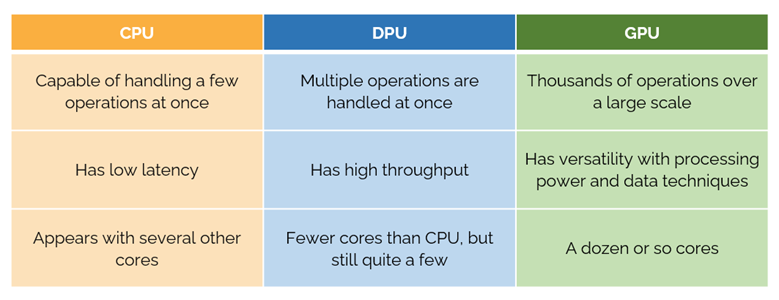Six Requirements for SmartNIC/DPU Integration in Existing Network Facilities

Six Requirements for SmartNIC/DPU Integration in Existing Network Facilities
CPUs have long been considered the backbone of computing processing devices, with GPUs for real-time graphics. Recently, however, it has been the data processing unit – the DPU – that has gotten a lot of attention.

SmartNIC/DPU
Network Interface Cards (NICs) have come a long way since the late 1980s. However, advanced as they were for their time, they were limited to simple connections between two computers or on a local network.
SmartNICs are programmable network cards that cover additional computing resources beyond regular NICs. A SmartNIC's programmable resources can consist of Arm cores, network processing units (NPUs), and other programmable units.
Many see DPUs as the next step in the evolution of SmartNICs.
DPUs are programmable devices that assist in data processing through hardware acceleration. SmartNICs efficiently connect servers to the network, and their programmable components are configured with accelerators to efficiently process data, freeing server space for application processing, but not for multitasking. While a SmartNIC can do the work of a DPU to some extent, they are not the same in composition and function.
SmartNICs offer extensive data storage and programmability, but it requires more virtualization capabilities from the DPU. There is a certain upper limit to the data managed by the SmartNIC, but when used in conjunction with the DPU, the data limit can be exceeded, thereby creating a reliable programmable technology that brings higher network processing capabilities.
In many cases, the terms SmartNIC and DPU are often used interchangeably.
According to data from research institutions, from 2019 to 2022, domestic and foreign companies have applied for many patents involving DPUs and related smart network cards, among which Intel ranks first, Huawei ranks second, and Google ranks third. Chip and processor makers such as AMD and Nvidia are already working on developing and manufacturing DPUs. Asus, Dell, and AMD have integrated with systems using Nvidia DPUs. AWS is also a major user of DPUs.

Why do existing network facilities need to integrate SmartNIC / DPU?
The server is overburdened
The constant pressure of Moore's Law drives the miniaturization of semiconductor technology every two years. Quantum tunneling, reduction in size of lossy layers, and development of parasitic capacitances lead to interconnect bottlenecks in server integrated circuits. The reduction in hardware size pushes servers to scale faster and increases the overall cost of CPUs.
storage and delivery
Forecasts point to the gigabyte era by 2040, with network infrastructure overwhelmed with storing data and delivering it on demand. To offload servers, the SmartNIC/DPU infrastructure provides data centers with gigabytes of additional storage, freeing up enough CPU cycles to perform high-value enterprise tasks and store critical information.
power consumption
Increasing server workloads are associated with additional hardware and devices required for power management. This hardware consumes additional power, increasing the cost of network infrastructure management. Power distribution units, backup and cooling mechanisms can help solve the problem to a certain extent, but the SmartNIC/DPU infrastructure directly does not require the deployment of additional hardware, and the total power consumption decreases as the number of cores decreases.
defensive attack
The SmartNIC/DPU infrastructure is capable of performing network security functions at the hardware level, including packet packaging, hashing, compression and decompression, encryption and decryption, cryptographic algorithms, firewalls, and DDoS attack defense. The SmartNIC/DPU can handle security operations and eliminate any threats without interfering with the server. The latest SmartNIC/DPU has firewall and advanced DDoS attack defense mechanism, supporting distributed security system.
Requirements for Integrating SmartNIC/DPU Infrastructure
SmartNIC / DPU can meet the growing demand for high performance, low latency and secure data transmission. But the implementation of SmartNIC/DPU requires a reliable network infrastructure. Following are some important requirements for integrating SmartNIC/DPU infrastructure.
high connectivity
NICs are typically used in low-bandwidth network infrastructures with speeds in the range of 10 Gbps. SmartNIC/DPU infrastructure is more suitable for large enterprises supporting large bandwidth, handling high network traffic, network speed over 100 Gbps, socket acceleration through multiple network layers to offload and save server cycles, for application-specific high value task.
ultra low latency
Implementations of SmartNIC/DPU perform best on wired infrastructure, and networks that need to perform high-speed computing use InfiniBand SmartNIC/DPU infrastructure. In such networks, Remote Direct Memory Access (RDMA) allows direct access to another computer's memory, providing ultra-low latency without involving the kernel.
Legacy infrastructure is better suited for Ethernet and faces complexities when implementing SmartNIC/DPU. Converged Ethernet-based RDMA supports Ethernet-based SmartNIC/DPU infrastructure, providing low latency and higher throughput.
complex network architecture
SmartNIC/DPU is suitable for the server side of the client-server model of enterprises and large cloud providers. Network architectures such as software-defined networking (SDN), network function virtualization (NVF), high-speed computing, and complex infrastructure provide conditions for SmartNIC/DPU to achieve hardware acceleration.
Distributed cloud computing companies from industries such as telecommunications, SaaS, e-commerce, and streaming media platforms have deployed hundreds or thousands of smart network cards for acceleration. These large organizations have network architectures that provide microservices and handle big data.
Network Switch Compatibility
A network can use many types of network switches. Compatibility and configurability of the SmartNIC/DPU with existing hardware (e.g. switches, operating systems) in the network is critical.
Certain SmartNICs/DPUs may not be compatible with the network infrastructure, requiring selection of compatible SmartNICs/DPUs for existing network switches, including interfaces, protocols, programmability, configurations and use cases.
SDN integration
Large enterprises often use SDN to connect, manage and accelerate their workflows across multiple workplaces around the world. Integrating SmartNIC/DPU infrastructure in such networks can offload the SDN centralized controller task to efficiently manage the network.
Since SmartNICs/DPUs are programmable, they can accelerate the data plane and application-specific tasks of routers and switches in SDN, including traffic forwarding, packet filtering, encryption and decryption, firewalls, etc.
NFV function
SmartNICs/DPUs are also used in networks employing NFV. NFV networks require the implementation of SmartNIC/DPU infrastructure as multiple virtual machines run on a shared physical infrastructure, eliminating the need for dedicated hardware.
This is similar to deploying virtual microservers across data networks, each with its own resources. Examples of NVF acceleration include Virtual Scalable LAN, micro-segmentation, and load balancing.
After implementing SmartNICs/DPUs in the network infrastructure, networking teams can turn their focus to managing SmartNICs/DPUs. Periodic quality checks after SmartNIC/DPU infrastructure deployment are the key to intelligent continuous acceleration. SmartNICs/DPUs allow for periodic audits of the network, storage and security functions themselves. Effective network management ensures seamless SmartNIC/DPU performance through monitoring software and key metrics.
Monitoring tools are constantly collecting and analyzing data such as latency, speed, throughput, and packet loss. Once a tool or SmartNIC/DPU detects an error, it must automatically troubleshoot to get a solution. In addition to troubleshooting, network management ensures that the SmartNIC/DPU infrastructure is regularly updated to meet the latest technology requirements. In addition, the network orchestration platform can also automatically configure SmartNIC/DPU to comply with current security operation regulations and standards.
summary
Integrating SmartNIC/DPU with existing network infrastructure is the key to ensure its successful application in the actual production environment. This seamless convergence improves overall performance and efficiency, reduces host processor load, and supports network virtualization, bringing greater flexibility and manageability to the enterprise. At the same time, the advanced network functions of SmartNIC/DPU can also enhance the security of the network and protect enterprise data and assets.
As technology continues to advance and requirements continue to change, SmartNIC/DPU will continue to play a key role, contributing to the continuous optimization of network performance and the improvement of application processing. We can foresee that the future network will be more intelligent and efficient, and bring more possibilities for innovation to enterprises.